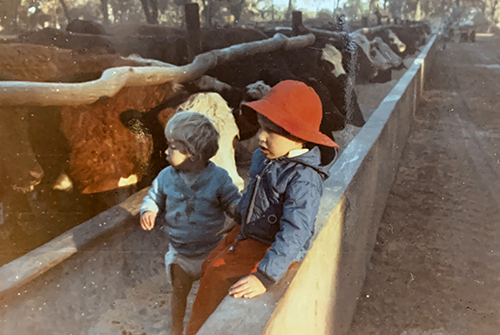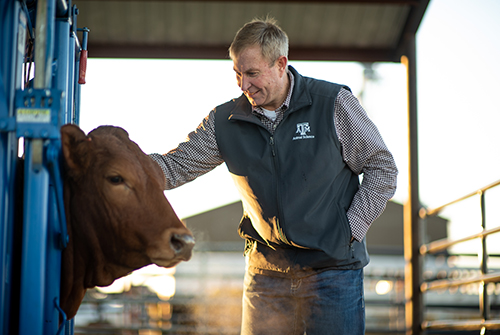A New Herd

Growing up on his father’s livestock and crop operation in Rhodesia, Dr. G. Cliff Lamb was surrounded by cattle, pigs and sheep almost from the moment he was born. The lifestyle influenced his interest in livestock reproduction and still informs his perspective today as head of the Department of Animal Science in Texas A&M University’s College of Agriculture and Life Sciences.
In Africa, Lamb also saw what can happen to food production in times of unrest. His homeland erupted into civil war from 1976 to 1979, resulting in the country’s reconstitution as Zimbabwe in 1980. Subsequently, in the late 1990s, the ruling party’s policies decimated the country’s once-bountiful agricultural industry as 6,000 farms were stripped from landowners, including those of the Lamb family and friends. The country’s food
Lamb’s career has been deeply influenced by watching the ramifications of this crisis unfold for his family, community, country and the surrounding nations in southern Africa. Those lessons help inform his approach to the looming threat of another food crisis: As the world’s population grows to a projected nine billion people by 2050, the global demand for animal protein will increase by 120%.
In preparation for this pending population shift, the beef cattle industry is focused on increasing its efficiency. “Dr. Lamb has offered a new approach to the department through his fresh thinking,” said Coleman Locke, a donor to the Department of Animal Science and president of J.D. Hudgins Inc., a family-owned ranch in Hungerford, Texas, that first developed the American Brahman breed in the 1920s. “He is building on all of the university’s previous successes and broadening the department’s horizons.”
Growing up, Dr. G. Cliff Lamb gained an appreciation for the animal industry from his father, Mick Lamb (right).
Lamb, who served as assistant director of the University of Florida-North Florida Research and Education Center before joining Texas A&M in 2017, is setting an innovative direction that deepens the department’s work while aligning it more closely with industry and global needs. “The production of animal protein using methods that are economically and environmentally sustainable for generations will be critical to feeding human populations in the future,” he said. “Generating science-based knowledge and disseminating that knowledge to students and stakeholders is the responsibility of our department.”
To that aim, the department’s research efforts are currently focused on several areas of excellence surrounding global animal protein production, including: learning more about cattle adapted to tropical and subtropical environments; focusing on pregnancy and the development of cattle; and maintaining the safety, quality and nutrition of food products.
A Breed Apart
The world’s growing demand for beef will primarily affect the southern United States, Mexico, Central and South America, Africa, Asia and Oceania. Producers in these areas will need to understand the breed-specific challenges related to increasing production. “There are 94 million cattle in the United States; in comparison, there are 220 million head of cattle in Brazil,” said Buck Thomason ’69, the owner of Indian Hills Ranch in Clifton, Texas, and a donor to Texas A&M’s International Beef Cattle Academy. “That’s the size of the market in Brazil, and those cattle must be heat tolerant because of the climate. Dr. Lamb recognizes that producing more heat-tolerant livestock is key to meeting industry growth, and he is steering the department in that direction.”

About 70% of the world’s beef cattle are located in tropical and sub-tropical regions. “These areas are best suited to Bos indicus-influenced breeds, such as the Brahman, Beefmaster, Brangus and Santa Gertrudis, which consume low-quality, forage-based diets and can tolerate heat, humidity and parasites,” Lamb said. “However, many cattle producers in tropical and sub-tropical regions utilize Bos taurus cattle, such as Angus and Hereford breeds, which are found in northern climates and have limited tolerance for heat, humidity, parasites and poor-quality forage. In other cases, cattle producers may raise Bos indicus cattle in these conditions but manage them in a way that Bos taurus cattle are raised in temperate regions of the world.”
Texas A&M animal science researchers are working to categorize how these two subspecies differ in bodily functions, such as nutritional requirements, efficiency, body composition, meat quality and reproductive physiology. This knowledge will help the industry optimize production efficiency in Bos indicus-influenced cattle.
Aggie students are also being prepared for this paradigm shift through an increased emphasis on globalization in undergraduate and graduate curricula as well as tailored opportunities for international travel to learn more from producers in tropical and sub-tropical areas. Last year, students studied abroad in New Zealand, Brazil and Mexico, all of which are home to Bos indicus-influenced breeds.
The department is further supporting the industry through the creation of the 44 Farms International Beef Cattle Academy, which graduated its first class in fall 2019. This innovative certificate program is designed to advance the knowledge of seasoned professionals around the globe who have a strong background in beef production. The academy offers online courses led by Texas A&M faculty and international guest lecturers who share the cattle industry’s latest technologies.
“Dr. Lamb’s vision for reaching out to cattle producers around the world, particularly in places that don’t have access to some of the technologies and research findings that we have in the United States, really fits with the mission of 44 Farms,” said 44 Farms CEO Bob McClaren, who made the academy’s naming gift. “Dr. Lamb just has a way about him that makes people want to work with him, learn from him and follow his vision.”
Managing the Beef Cycle

The viability of the world’s cattle industry depends on the success of breeding operations as well as attention to post-natal development.
“My research involves enhancing reproductive efficiency in cattle operations to increase the overall productivity and sustainability of beef production systems,” Lamb said. “Any research that enhances pregnancy success and delivery of a high-performing live calf has a great economic impact on the beef cattle production system.”
Lamb is also committed to ensuring that students understand issues related to livestock reproduction. Undergraduate students can take reproductive biology courses that include interactive laboratories and participate in faculty research projects, while the department also offers graduate degrees in animal science, animal breeding and genetics, and physiology of reproduction.
Just as improving reproductive efficiency plays an important role on the front end of the beef cycle, so does producing a safe, high-quality and nutritious food supply on the back end. This also has significant economic ramifications, including for the state of Texas. Approximately 30% of the nation’s beef cattle are fed prior to harvest in a five-state region that includes the Texas Panhandle, an area home to 2.5 million beef cattle and a large number of dairy cattle at any given time. Additionally, the manufacturing and sale of meat, poultry and related products generate an estimated $87 billion in economic activity in Texas.
Already a leader in this area, the Department of Animal Science continues to offer more meat science and food safety courses than any other U.S. university as well as a meat science and food safety certification. Home to the largest number of meat science faculty in the nation, the department’s researchers are experts in areas such as sensory and flavor chemistry, fatty acid biochemistry, fresh meat quality and food safety. Students may also participate in value-added activities, such as judging teams, internships and research projects.
An Individual Passion
Lamb’s wide-ranging experiences give him a deep understanding of the complexities of the food supply chain. While he understands the current interest in plant-based proteins, he notes that growing only plant-based products for human consumption creates monoculture agricultural systems, which are simply unsustainable. In comparison, livestock are a vital part of creating a viable polyculture. “Livestock convert poor quality forage into high quality proteins. If you put cattle on marginal land, they will convert that into highly nutritious meat,” he said. “In addition to recycling nutrients, they are creating good environments for other wildlife—birds, insects and other mammals. In my mind, livestock production is a highly important part of a sustainable food system.”
It’s this mindset that Lamb wants to foster among the department’s students. To that end, he and his wife, Margo, have personally underscored their commitment to the department through the establishment of a fellowship to recruit high-performing graduate students. The decision came easy since Lamb benefited from scholarships during his own undergraduate and graduate years. “If it wasn’t for scholarships and support from people, I wouldn’t be where I am today,” he said.

The couple strategically structured their gift to demonstrate how easy and affordable it is to give. “Many people get sticker shock when they see the cost of an endowment,” Lamb said. “We wanted to create our gift in such a way that we could give people examples of how we’re funding it. By paying for it over time while using matching dollars from our employers, it is more manageable.”
Lamb stressed that securing additional funding is critical to support the department’s groundbreaking work. “As public funding continues to provide a smaller proportion of the operating resources for departments like ours, it is highly important for us to partner with granting agencies, private individuals, and other non-public resources who desire the success of our students and stakeholders. It’s also essential that we generate science that our partners can trust and apply to the sustainability of livestock systems,” he added. “To do this, we will need to be more creative and entrepreneurial to effectively support our programs as we retain our status as the leading Department of Animal Science in the world.”
Beef it Up
The Department of Animal Science is in the midst of transformational change. “We want to be known nationally and internationally as the Department of Animal Science and the leader in beef cattle production systems,” Lamb said. To support these goals, the department has established seven key funding areas for its beef initiative through the Texas A&M Foundation. If you are interested in making a gift to support one of these priorities, please contact Scott Jarvis ’00 using the form below. You can also give to the department online.
-30-
Via source, Texas A&M Foundation Spirit } A New Herd